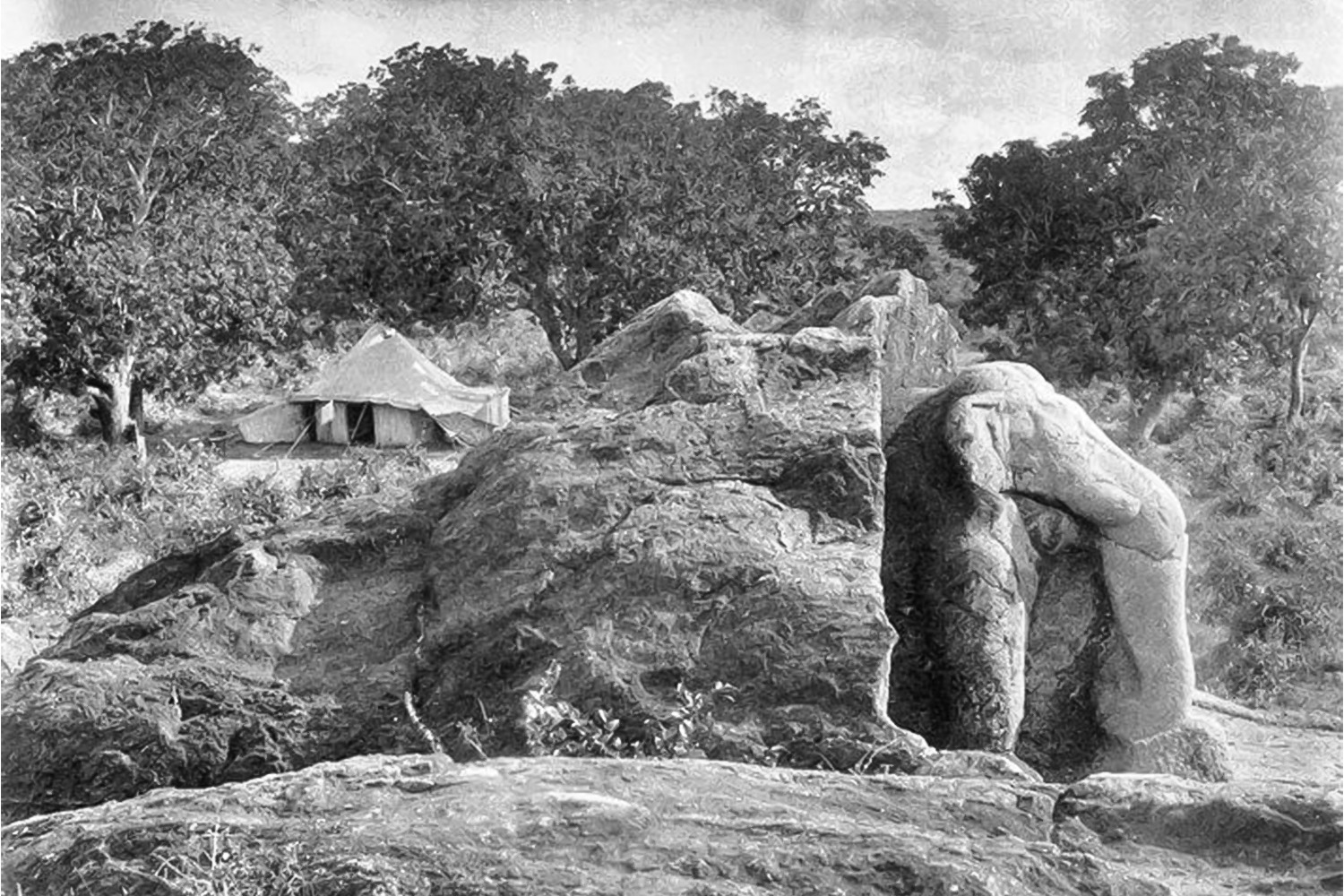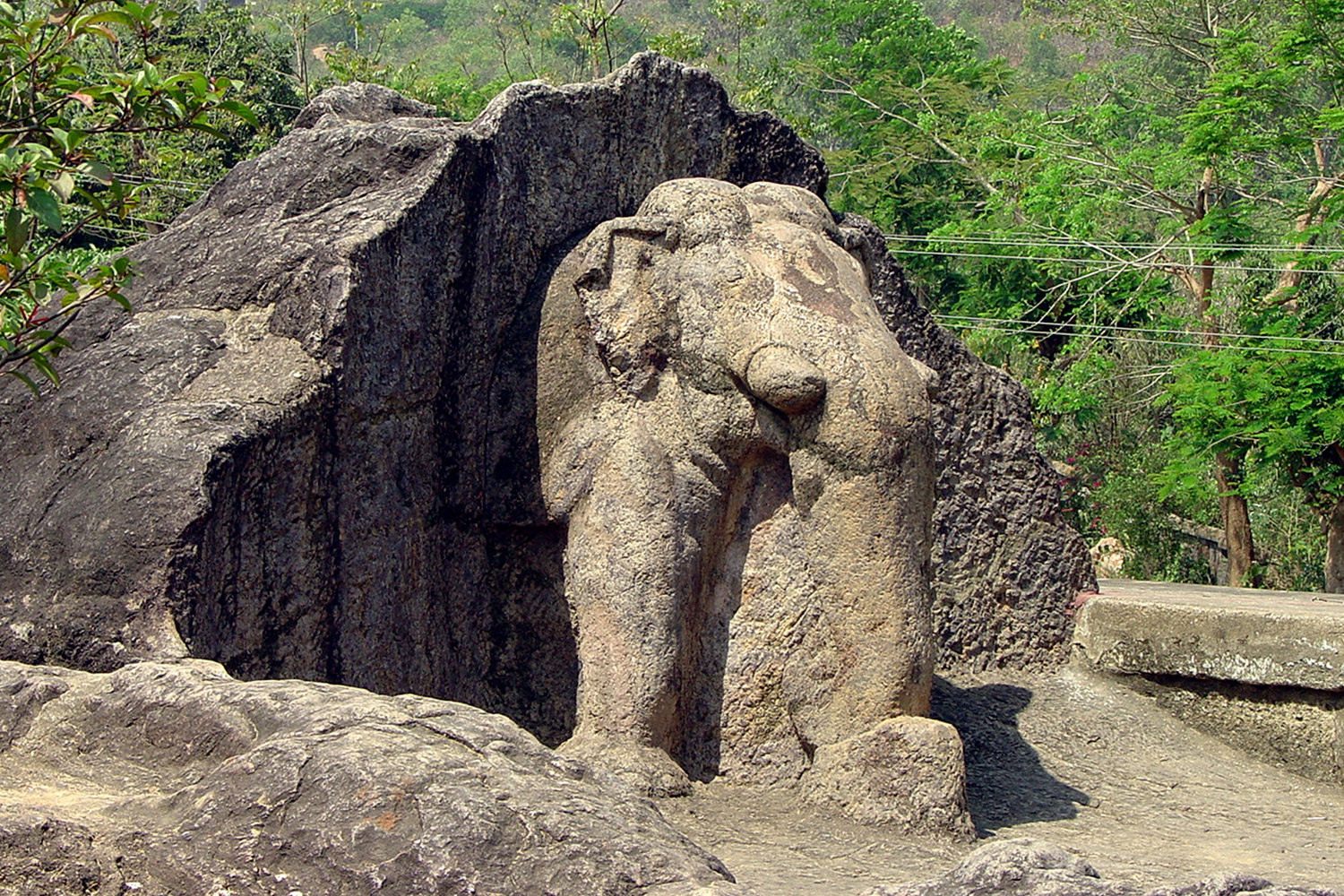ARTICLE
Dhauli Elephant
The earliest rock-cut sculpture in Odisha, India, the elephant at Dhauli, near Bhubaneswar, is notable for its naturalistic style. Discovered by Markham Kittoe, a British colonial officer, in 1837, it has been dated to 257 BCE, and is believed to have been carved by local artisans in the village with the patronage of Mauryan emperor Ashoka soon after the Kalinga War. The four-foot high sculpture constitutes the upper eastern face of a rock popularly known as Ashvathama, which has the Ashoka edicts inscribed on its lower, northern side.
Rendered in a supple, naturalistic style, only the front parts of the elephant — head, ears, trunk and forelegs — are visible, while the rest of its body appears to be engulfed in a mass of stone, such that the elephant looks as if it is either stuck within or emerging from the rock. Scholars have proposed that this might be symbolic of the halting of Ashoka’s war at Dhauli, the site of the Kalinga War, which led to his conversion to Buddhism. The softness of the elephant’s body stands in distinct variance from the regulated formalism of Mauryan animal capitals, pointing to the continuation of a different, perhaps more local sculptural tradition that came to find representation even in later Mauryan art, such as the elephant capital of the Sankisa Pillar and the Rampurva Bull.
The Dhauli Elephant has significant religious symbolism and local lore associated with it. Elephants appear frequently in Buddhist literature, particularly the Jatakas and are considered to be symbols of both temporal and spiritual sovereignty. The word ‘seto’, meaning ‘the white one’, inscribed at the end of the Sixth Edict of Ashoka, is generally associated with the Elephant at Dhauli. According to Buddhist tradition, white or albino elephants embody purity and holiness and represent the penultimate incarnation of the Buddha before the Shakyamuni Buddha.
At the time of writing, the Dhauli Elephant has become a locally venerated work as well as a major tourist attraction, and helps draw attention and crowds to nearby structures, including the edicts, the Shanti Stupa, and temples and caves.
Bibliography
Geer, Alexandra van der., Geer, Alexandra Anna Enrica van der. Animals in Stone: Indian Mammals Sculptured Through Time. Netherlands: Brill, 2008.
“Indian Sculpture.” Britannica. Accessed February 21, 2023. https://www.britannica.com/art/South-Asian-arts/Visual-arts-of-India-and-Sri-Lanka-Ceylon
Patra, Benudhar. “Dhauli : An Early Historic Urban Centre of Orissa.” Orissa Review, July 2006. http://magazines.odisha.gov.in/Orissareview/july2006/engpdf/49-53.pdf.
Ray, Niharranjan. “Animal Symbols in Maurya Art: Formal and Cultural Significance.” Accessed January 31, 2023. https://himalaya.socanth.cam.ac.uk/collections/journals/bot/pdf/bot_1977_02_01.pdf
Sistla, Srinivas. “White One & a Matrix of Cloud, the Dhauli sculpture.” The New Indian Express. January 02, 2021. Accessed January 31, 2023. https://www.newindianexpress.com/opinions/2021/jan/27/white-one–a-matrix-of-cloud-the-dhauli-sculpture-2255502.html
Srinivasan, Doris Meth. “The Immobilised Elephant at Dhauli.” Journal of the Royal Asiatic Society (2022): 1–2. doi:10.1017/S1356186321000924.
Williams, Joanna. “The Eponymous Elephant of Elephanta.” Ars Orientalis 30 (2000): 51–58. http://www.jstor.org/stable/4629569







![The façade of the Maneckji Seth Agiary, a Zoroastrian fire temple, is a standout example of the popularity of the Persian Revival Style in Western India in the 19th and 20th centuries. This style was often seen in the architectural patronage of the Parsis, who emerged as one of the most influential mercantile communities of British India. Popular motifs of this style, like the mythical lamasus (winged bulls with human heads) and the faravahar (a winged guardian spirit in Zoroastrianism), drew on the historical art and architecture of the Achaemenid and Sasanian empires from sites like Persepolis, Bisotun, Taq-e Bostan, Naqsh-e Rostam and Naqsh-e Rajab in Persia.
The Parsi community’s adoption of this style occurred largely due to their networks of global commerce and politics, allowing them to access and translate research of ancient Persia into visible symbols that underlined their association with antiquity, imperial power, and art.
نمای آتشکدهی زرتشتی مانِکجی سِت نمونهی بارزی از رواج سبک «احیای [معماری] ایرانی» در غرب هند طی سدههای نوزدهم و بیستم است. این سبک غالباً در بناهایی دیده میشد که پارسیان، از بانفوذترین جوامع بازرگان در هند بریتانیا، بانیشان بودند. نقشمایههای محبوب این سبک، مانند گاو بالدار اساطیری (لاماسو) و فَروَهَر (روح بالدار نگهبان در دین زرتشت)، برگرفته از هنر و معماری شاهنشاهی هخامنشی و ساسانی، در جاهایی چون تخت جمشید و بیستون و طاق بستان و نقش رستم و نقش رجب، بود.
اقتباس جامعهی پارسیان از این سبک بسیار مرهون روابط گستردهی تجاری و سیاسی آنها بود که دسترس به پژوهشها دربارهی ایران باستان و برگردانیدن آنها به نمادهای بصری را ممکن میکرد و بر پیوند پارسیان با دوران باستان و قدرت شاهنشاهی و هنر تأکید میکرد.](https://mapacademy.io/wp-content/plugins/instagram-feed/img/placeholder.png)
